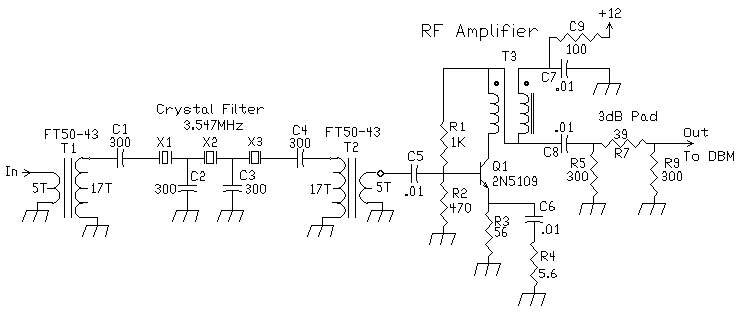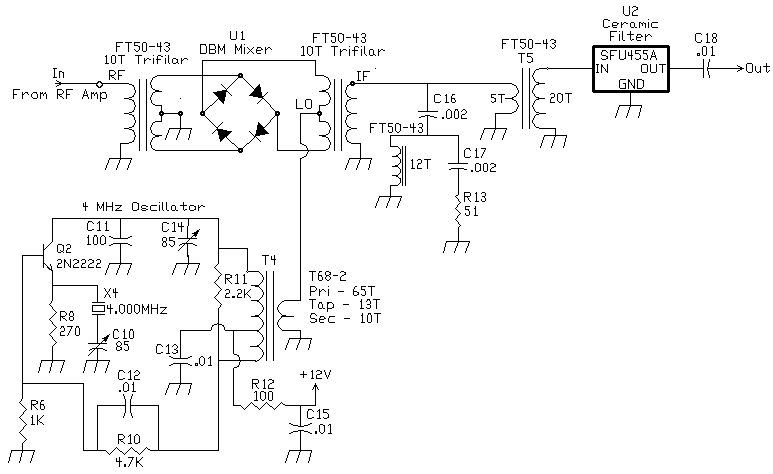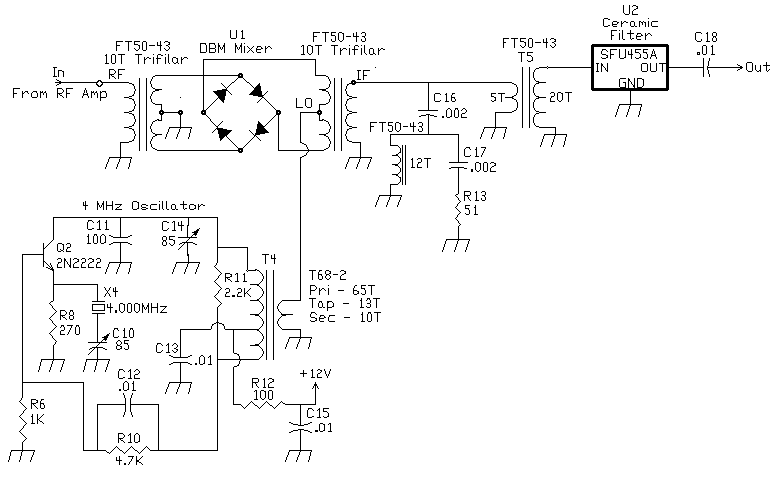




|
The crystals are 3.547 MHz available from BG Micro and many other surplus companies. I have found that almost all the 3.547 crystals I have procured from any source have had a very high "Q" factor and have resulted in very good CW filters. The capacitors used are 300pf. The resulting end impedance is between 200 to 300 ohms and are matched with 1:4 regular transformers. I used 7 turns to 15 turns. I have found that these crystals come very well matched from the suppliers. I have rarely gone to the trouble of matching them, and the ones I have measured have been within 100Hz of each other with few exceptions. I don't have any sophisticated measurement devices, but I have estimated through my crude measurements that the one filter strip yields about a 500Hz bandwidth and the two filter strip yields about a 250Hz bandwidth. In order to enjoy this type of selectivity, you must have a very good dial mechanism. When I first used this sharp selectivity, all those neat venier dials and tuning mechanisms I had collected over the years showed their failings. Backlash, worn gears, pitted ball bearings, cheap construction, drifting VFO's and a lot of other problems became very visible. What I found to work was sometimes very surprising. I wound up putting this receiver in a broken down HQ-140X. The tuning dial in that receiver was the best I had ever come across. And all it consisted of was a plastic dial and a circular metal piece into which the dial fit. Very simple, extremely good and from an old piece of equipment that you would never expect that kind of quality. The tuning knob is the perfect size and absolutely no backlash or slop. Picture Doug Hildredth used to write a lot of articles for Ham Radio describing very sharp filters for CW use. His opinion was that the limitation of useful selectivity was in the mechanical part of the dial and not in the electrical circuitry. He had pushed the limit of useful filter bandwidths (down to 100 Hz and even 50 Hz) and was well aware of the problems of just tuning a high selectivity receiver. Expect to spend some time finding something that will work with this selectivity. You will not enjoy this receiver if you don't find a very good tuning mechanism. One homebrew solution in the book, Radio Projects for the Amateur, by Drew Diamond, VK3XU, printed by The G QRP CLUB, is the article "Simple Tuning Dial from Junk Box Parts", Page 41. His dial works like the Hammarlund dial and is very easy to construct. There are a lot of good construction ideas in that book. Also see "Using a CDROM as a Reduction Drive" in the Electroluminescent Receiver Kit Section of this site. This drive, if set up carefully, works as well as the HQ-140X drive. |


|
When cascading filters matching the impedances is very important, or the series resonant value of the crystals will be so far off that the signal from the first one can't get through the second one. The crystals must be identical and use the same value capacitors in both filters. It also helps to construct them alike, i.e., don't build one 'ground plane' style and the other one on a printed circuit board. My best success has been building them 'ground plane' style with identical dimensions. |
|
"Ladder Crystal Filter Design", by J. A. Hardcastle, November 1980, QST, Page 20. "A Unified Approach to the Design of Crystal Ladder Filters", by Wes Hayward, May 1982, QST, Page 21. This was the first article that hinted at the fact that regular computer crystals or color burst crystals could be used in a very effective homebrew crystal filter. "Designing and Building Simple Crystal Filters," by Wes Hayward, QST, July 1987, P 24. This article showed how using the same capacitance for each capacitor in a crystal ladder filter gave very good results, very inexpensively, and easily adjusted bandwidth. |

Send E-Mail || Amateur Radio Receivers || Super Receiver || Super Receiver Circuit Details

